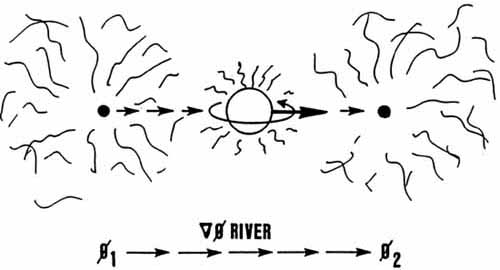We
show clearly on this slide that a spinning charged particle, when it
hooks to a spin-hole in a del-phi river, MOVES ITSELF.
Note
that a del-phi implies a "pressure difference" in phi-flux
between two points. Therefore there is a moving river -- a
gradient -- of phi-dot, moving from the higher pressure to the lower.
If
a charged particle is attached to this moving river, it flows along with
the river. It is just like putting a boat into a moving
stream of water. If the boat "latches" to the moving
water, it moves with the river.
Electron
spin and spin vortexes in the del-phi mesh, to accomplish the
"hooking" or "latching."
Once
hooked into a moving river, the electron moves itself. One does
not have to furnish work to move it.
If
the river is accelerating, the electron will accelerate itself.
By
cleverly gating such rivers into and onto sources of free electrons, one
can directly produce free energy.
The
extra energy comes from converting anenergy (massless charge, vacuum
flux) to energy of a moving mass.
Next Slide
|

